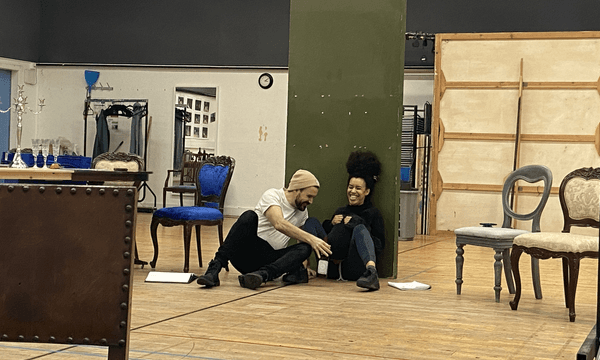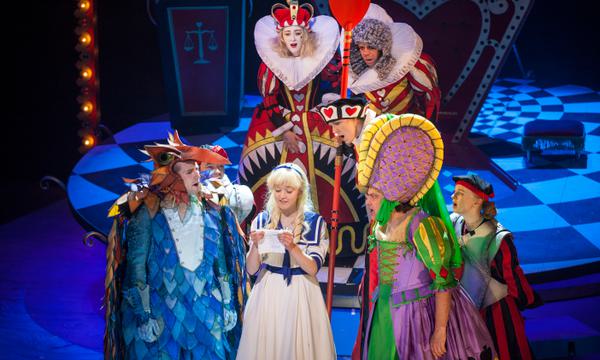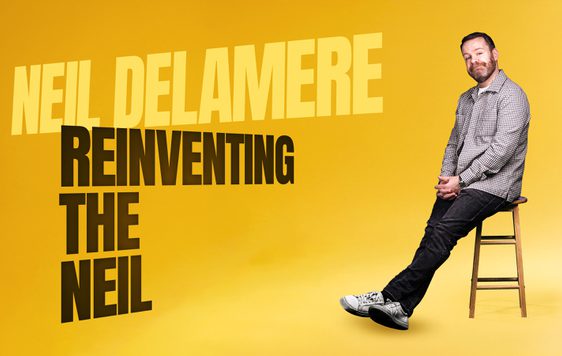News Story
Lighting can completely change how an audience view a performance, it might not be the thing you are focusing on when watching a Lyceum show but it will definitely be the thing that influences how you feel during a scene. It can show you the setting of a scene, the time of day, create an atmosphere and even influence the way to feel about a certain character. There is a lot of thought that goes into lighting a show and the choices that are made by the designer, I reckon after reading this post you will look at lighting a little differently during Macbeth (an undoing).
I sat down with Maria and Ross, our lighting gurus, at the lighting desk behind the stalls, to talk all things lighting, charts, desks and careers.
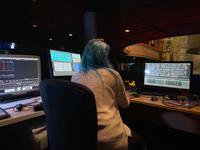

When setting up the lights in the theatre, who is in the room and what is their job? What is the process?
Us two, Ian, a couple casuals, a flyman and a loader. There is a lot to get up and not a lot of time to do it in, so we have people come and help. The flyman and loader are there to help balance out the weight on the lighting bar when it flies in and out of the stage.
We normally get a lighting plan / rig sheet with distances between the lighting. We then put them all up where they should be and flash the rig (this is when you turn the lights on and off to make sure they all work) this is all done before the lighting designer is in the building – this helps with finishing in time, so the lighting plan needs to be accurate.
The lighting designer then shows up and if everything is set up how they want it we then do a focus. A focus is when we turn all the lights off and go through every light individually, we point them all in the right direction, make the beam look right and put the colour in. This usually takes a day or two – it is the longest part of our job and can get very hot with all the lights and being so close to them.
Have you always wanted to work in lighting? What was your 1st job in the industry?
Ross: No. I was a computer programmer before I got into theatre. When I got into theatre, I wanted to be stage manager but I wasn’t very good at it but I was good at lighting. I just fell into lighting by default. I wanted to be a pilot. Straight after college I got employed as a lighting tutor and technician, that was my first job in theatre.
Maria: I wanted to be a stage manager too. I was a deputy stage manager for a bit but I didn’t enjoy it so I landed into lighting, and I got good at it so I stayed with it. I mostly did design for music but with live music rather than theatre. I was a production manager for a youth theatre straight after college which was my first paid job in the industry.
What do you have to think about when designing lighting?
Reflecting the script on the stage. Many directors ask whether the lighting is reflecting the time of the day, the location, the atmosphere, even the character's mindset if you want to go more abstract. Is the lighting true to the script? A lot of it depends on the directors and set designers of the production – do my ideas fit with the directors, it is a collaborative process. You also have to think about the practicalities of the lighting, set getting in the way, bending light around corners, effects that are needed in certain scenes.
The boring part is having to think about the budget, you may want a really exciting light that does everything, but you can’t afford that so as a lighting designer you have got to think about how you can achieve that same effect with what we have in house. Budget normally comes before creativity – you have got to be creative within guidelines, but there are a lot of things that you can do within a budget.
There are a lot of designers who can use generic lighting and achieve a lot with it, making amazing effects.
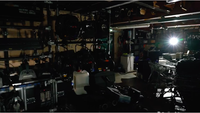
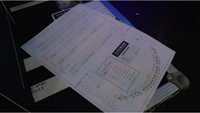
Talk me through how to read a lighting chart / rig sheet
If you break it down, it’s quite easy to read. There is a key to identify what the different lights are along the side of the sheet and below a guide to the numbers around the light. The number in front of the light is the colour it is and the number behind is the channel number. Every light has a channel number so the desk knows what you are talking about – think of the channel number like the light’s address, so you know where it lives. The rig sheet just helps us to see where on the stage the light is, so we know which ones to light up.
So, if you want to use a light on stage, you enter the channel number on the desk and give it a value, which is how bright you want it to be between 1-100, if you are happy, you cue it in. The chart also tells us if the light is an intelligent fixture which means it is LED so there is no set colour on it and you can pick whatever colour you want by using the colour chart on the computer screen.
We have different plans for the FOH lighting and the lighting above the main stage. We get a new lighting plan for every show – no two are the same so we get the rig sheet plan through which tell us what lights are being used where.
When we are rigging (putting the lights up before tech) we don’t care too much about the channel numbers because we are looking at the colour number – this is so that we put the right coloured light up in the air to be used in the right place.
Talk me through a lighting desk
The desk tells the lights what to do. It uses DMX as the language, which is a computer protocol, all desks tend to use a variation of it as it’s been around for years, and it works.
We run the show on a cue list which is programmed into the desk – each cue is a lighting state change, and it is triggered by the go button which is clicked when the Deputy Stage Manager who is calling the show, says go over the headphones. The cues have numbers and a description about what they are on the screen, which is optional but helps if you're swapping board operators or the show is going on tour.
The great thing about what we use is that the whole show is programmed into the computer and saved onto a USB, this allows the show to go on tour and move venues without having to re-do the whole lighting for the show...as long as they have the same programme and desk as you, which most venues do to varying levels and desk sizes (or you can take your lighting board with you). There is always one venue which doesn’t as it can be more of a music venue than a theatre venue and they use a different programme so you have got to start from scratch.
The numbers on the screen and cue sheet also match the numbers on the lighting on the plan, so you know which light should be coming on, and if it doesn’t light up you know which one you need to go and check the bulb on rather than having to check them all.
Top tip: make sure that your lighting board keys are up to date with the programme on your desktop or the key you think you’re pressing, won’t be the right one.
Where do we store the lighting when it isn’t being used?
All our lighting is stored under the stage. FOH lighting (the ones above your head) aren’t moved, they are constantly rigged. There are about 20 lights in the gods as well as a couple follow spots.
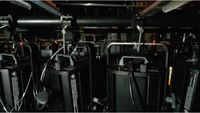

How do you get the lighting up above the stage?
With the fly bar. It is dropped to stage level, we put all the lights on it and then it is lifted back up again before being focused.
Do you only use the Lyceum lighting, or do we rent out/borrow lighting for shows too?
We use both. A lot of the lighting is rented from companies. We own a lot of lights, but we don’t own anything that is too new. Moving lights are expensive and always changing, they also need a lot of maintenance which can be quite expensive. If we had bought new lighting over the years, they would be out of date within two years so not worth the investment, nowadays lighting is a lot more stable so we could buy our own, but storage becomes difficult.
Different lights will be used for different effects, and sometimes we need lots of the same kind of light to make a certain effect which is why the Lyceum has so many.
Fun fact: The Lyceum has over 200 lights, some dating back to the 1930s. We even have the original electrical lighting that was bought by Howard and Wyndham who built the theatre. We don’t use them anymore but it’s amazing to see a bit of history.
How do you create lighting effects on the stage? Any tips for when you don’t have a desk?
Some are pre-programmed onto the desk, and you can also make your own. There is also a lot of ‘do-it-yourself’ lighting. KK wheels that spin slowly with patterns on them, you just need to put the wheel in front of a generic light and there are lots of effects that you can make such as fire.
LED tape is handy to have for effects too. You can put it inside boxes to make them light up, the tape can also flicker – it just needs to be plugged in and you can have lots of different colours.
Tell us something about your job that people would be surprised to hear.
I read lots of books while operating shows, once a show is in operation, you have got to pay attention but if there aren’t many cues you are sat glancing up at the show, checking it’s going right and waiting for your next button click. You are at height a lot. Working up high is a big part of the job and having to get into awkward positions to fit and fix lights. You get electrocuted now and again. You end up fixing and making things that you wouldn’t think you would be able to. A lot of the job is problem solving with lighting – how can we light a fireplace with 3 lamps and a bit of cable instead of buying something brand new.
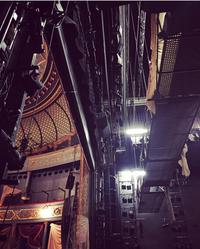
What is the hardest thing about your job / what is your favourite thing?
Maria: My favourite thing is seeing children and audiences love the shows we make. When you go to the theatre, and you see something that sticks with you for such a long time and it’s that feeling of knowing that we created that. If one person leaves our show and a love of theatre has been ignited, that’s amazing. I wish I had opportunities to see theatre when I was younger and engage in this world.
Ross: I love it when the audience are enjoying themselves, it makes such a difference sitting behind the desk - I can see the audience so I can see if they aren’t enjoying themselves, if they are, I am too.
Maria: The long hours are hard, and you can miss out on life and things that others are doing. I also hate going up in the grid. The other day I went up to fix something, took two steps and froze because I didn’t have a harness as it is all enclosed and safe, but my brain doesn’t tell me that.
Ross: The hours are hard and carrying very heavy things to awkward places.
Advice for someone wanting to do your job?
Maria: Don’t take every job you get offered. When you are young, and keen don’t take all the jobs. There are 3 questions you have got to answer before you take a job, if you answer yes to 2 or more of the questions you should take the job, if not ignore it. 1) are you going to enjoy it, 2) will it pay the rent 3) will you make any connections? Know your worth.
Ross: Think hard about it, it’s a commitment and you miss out on things, you don’t get paid well but it is a lot of fun and such a rewarding job. You have got to love theatre. Look after yourself, if you are working freelance make sure you take time for yourself so don’t take all the work and burn out. People always want lighting technicians and designers.
Next time you’re in the theatre – turn around and wave to our amazing lighting team sitting behind you.
